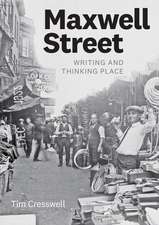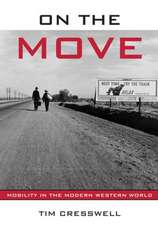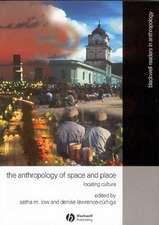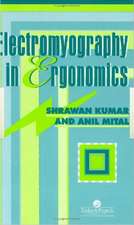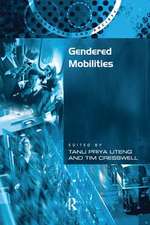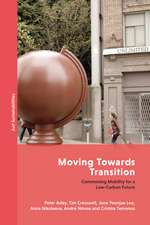Geographies of Mobilities: Practices, Spaces, Subjects
Autor Tim Cresswell Editat de Peter Merrimanen Limba Engleză Hardback – 23 dec 2010
| Toate formatele și edițiile | Preț | Express |
|---|---|---|
| Paperback (1) | 459.92 lei 43-57 zile | |
| Taylor & Francis – 16 ian 2013 | 459.92 lei 43-57 zile | |
| Hardback (1) | 1113.63 lei 43-57 zile | |
| Taylor & Francis – 23 dec 2010 | 1113.63 lei 43-57 zile |
Preț: 1113.63 lei
Preț vechi: 1358.09 lei
-18% Nou
Puncte Express: 1670
Preț estimativ în valută:
213.10€ • 223.05$ • 177.36£
213.10€ • 223.05$ • 177.36£
Carte tipărită la comandă
Livrare economică 31 martie-14 aprilie
Preluare comenzi: 021 569.72.76
Specificații
ISBN-13: 9780754673163
ISBN-10: 0754673162
Pagini: 288
Dimensiuni: 156 x 234 x 18 mm
Greutate: 0.58 kg
Ediția:1
Editura: Taylor & Francis
Colecția Routledge
Locul publicării:Oxford, United Kingdom
ISBN-10: 0754673162
Pagini: 288
Dimensiuni: 156 x 234 x 18 mm
Greutate: 0.58 kg
Ediția:1
Editura: Taylor & Francis
Colecția Routledge
Locul publicării:Oxford, United Kingdom
Notă biografică
Tim Cresswell is Professor of Human Geography at Royal Holloway, University of London, UK and Dr Peter Merriman is a Senior Lecturer in HumanGeography at the Aberystwyth University, UK
Recenzii
'Movement, mobility, speed, travel!...Just a few of the words used to frame modern geographies. But what does this "new mobilities paradigm" really describe? This glorious book tells you through a series of acute and fascinating contributions which open up this new world to inspection and analysis.' Nigel Thrift, University of Warwick, UK 'Every library should own this book; it provides an opportunity for readers to witness firsthand the elegant complexity of geography...Highly recommended.' Choice Transport geographers and mobilities scholars alike, not to mention those who regard themselves as having a foot in both camps, will have something to gain from reading this collection of essays...this is an important book that will find itself on library shelves and the reading lists of postgraduate and higher-level undergraduate students. It will provide a foundational understanding of work that is ongoing across mobilities scholarship, and should whet students and academics’ appetites for more detailed excavations of the literature. Area, March 2012 'This edited volume makes an important and wide-ranging contribution to the expanding body of mobility research.' Social and Cultural Geography
Cuprins
Introduction: geographies of mobility a practices, spaces, subjects, Tim Cresswell and Peter Merriman; Part I Practices: Walking: new forms and spaces for studies of pedestrianism, Hayden Lorimer; Running: running as working, John Bale; Dancing: the secret slowness of the fast, J.D. Dewsbury; Driving: pre-cognition and driving, Eric Laurier; Flying: feminisms and mobilities: crusading for aviation in the 1920s, Dydia DeLyser. Part II Spaces: Roads: Lawrence Halprin, modern dance and the American freeway landscape, Peter Merriman; Bridges: different conditions of mobile possibilities, Ulf Strohmayer; Airports: terminal/vector, Peter Adey; Immigration stations: the regulation and commemoration of mobility at Angel Island, San Francisco and Ellis Island, New York, Gareth Hoskins and Jo Frances Maddern; Cities: moving, plugging in, floating, dissolving, David Pinder. Part III Subjects: Commuter: mobility, rhythm and commuting, Tim Edensor; Tourist: moving places, becoming tourist, becoming ethnographer, Mike Crang; Migrant worker: migrant stories, Elizabeth Lee and Geraldine Pratt; The vagrant/vagabond: the curious career of a mobile subject, Tim Cresswell; Refugees a performing distinction: paradoxical positionings of the displaced, Alison Mountz; Index.
Descriere
Geographers have always had an interest in mobility, but as yet they have not viewed this in the same 'mobility turn' as in other disciplines where it has been used to critique the standard approaches to the subjects. This text brings together leading academics to provide a revitalised 'geography of mobilities' informed by this wider 'mobility turn'. It makes connections between the seemingly disparate sub-disciplinary worlds of migration, transport and tourism, suggesting that each has much to learn from each other through the ontological and epistemological concern for mobility.


